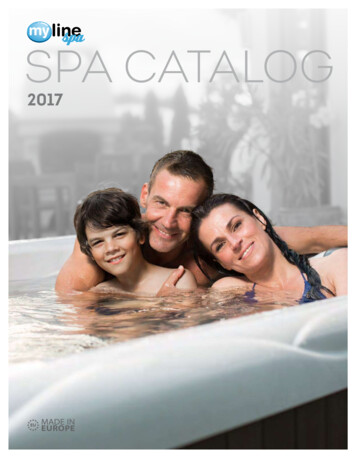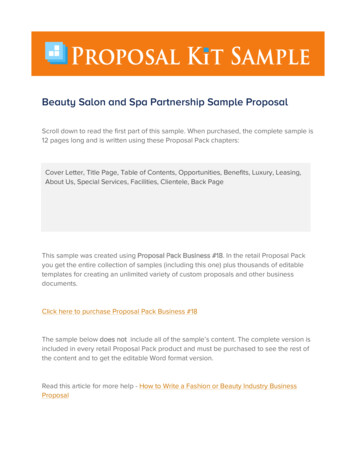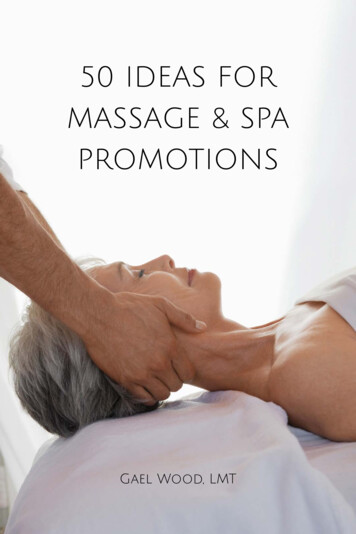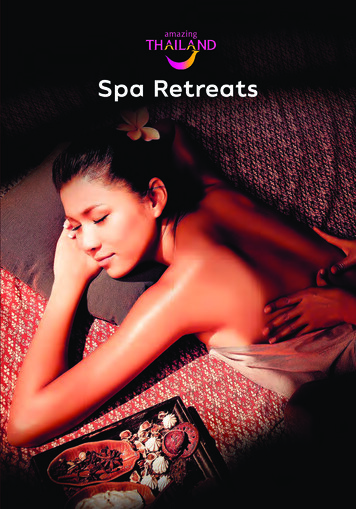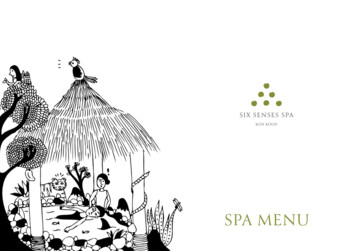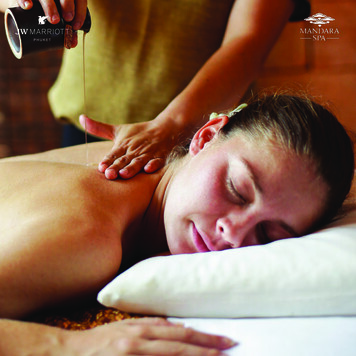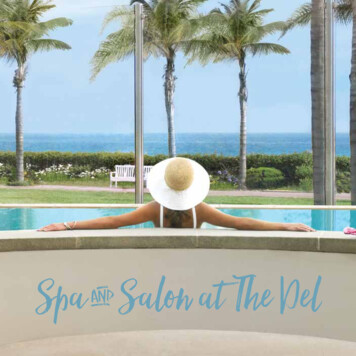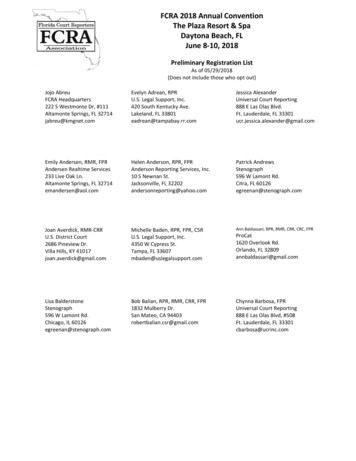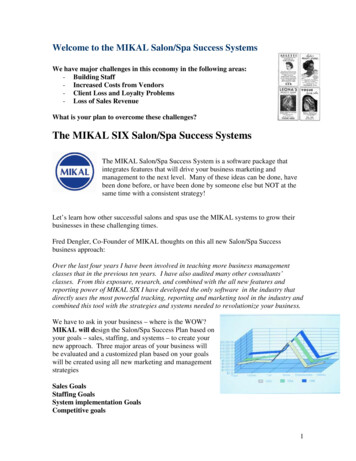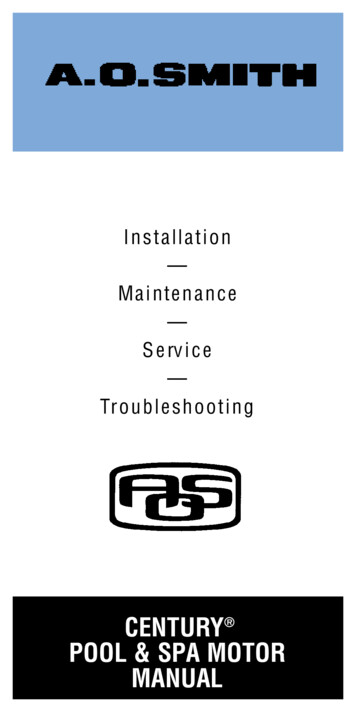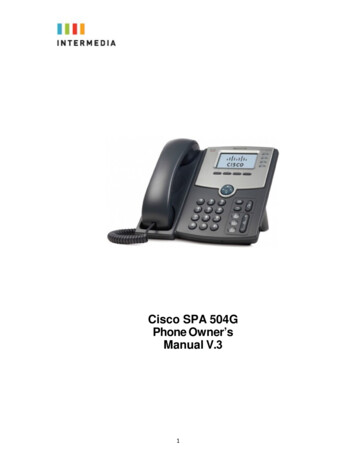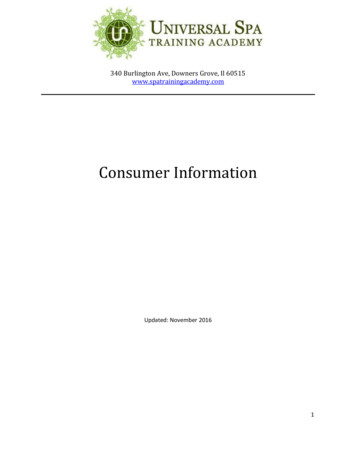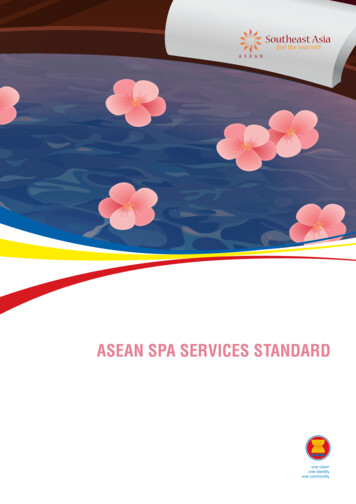
Transcription
ASEAN SPA SERVICES STANDARDone visionone identityone community
ASEAN Spa Services StandardThe ASEAN SecretariatJakarta
The Association of Southeast Asian Nations (ASEAN) was established on 8 August 1967. The Member Statesof the Association are Brunei Darussalam, Cambodia, Indonesia, Lao PDR, Malaysia, Myanmar, Philippines,Singapore, Thailand and Viet Nam. The ASEAN Secretariat is based in Jakarta, Indonesia.For inquiries, contact:The ASEAN SecretariatPublic Outreach and Civil Society Division70A Jalan SisingamangarajaJakarta 12110IndonesiaPhone : (62 21) 724-3372, 726-2991Fax: (62 21) 739-8234, 724-3504E-mail : public@asean.orgCatalogue-in-Publication DataASEAN Spa Services StandardJakarta: ASEAN Secretariat, January 2016338.47911. ASEAN – Tourism2. Health Treatments – Spa Service – GuidelinesISBN 978-602-0980-75-1General information on ASEAN appears online at the ASEAN Website: www.asean.orgThe text of this publication may be freely quoted or reprinted, provided proper acknowledgement is given anda copy containing the reprinted material is sent to Public Outreach and Civil Society Division of the ASEANSecretariat, JakartaCopyright Association of Southeast Asian Nations (ASEAN) 2016.All rights reserved
ASEAN SPA SERVICES STANDARD
INDEXI.1.2.3.4.5.ASEAN SPA SERVICES STANDARDPrefaceIntroductionScopeTerms and Definitions4.1. Spa4.2. Types of Spas4.2.1. Day Spa4.2.2 Club Spa4.2.3 Hotel / Resort Spa4.2.4 Mineral Spring Spa4.2.5 Cruise Ship Spa4.2.6 Destination Spa4.3. Aromatherapy4.4. Client4.5. Establishment4.6. Hydrotherapy4.7. Massage4.8. Massage techniques4.9. Natural Resources4.10. Spa Cuisine4.11. Spa Services4.12. Spa Manager4.13. Spa Trainer4.14. Therapist4.15. Top Management4.16. Traditional Massage4.17. Traditional and Cultural Treatments4.18. Treatment4.19. WellnessMajor Criteria and Requirements5.1. The Place5.1.1. Location5.1.2. Reception5.1.3. Treatment Areas5.1.4. Cleanliness5.1.5. Construction5.1.6. Wet Areas5.1.7. Safety5.1.8. Lighting5.1.9. Ventilation5.1.10. Waste Management5.1.11. Client Facilities5.1.12. Decoration5.1.13. SEAN Spa Services Standard - Indexi
5.2.5.3.5.4.5.5.5.6.5.7.ii5.1.14. Furniture5.1.15. Accessibility5.1.16. Back Office AreasThe Service5.2.1. Operating Hours5.2.2. Consultations5.2.3. Menu5.2.4. Protocols5.2.5. New Protocols5.2.6. Spa Services5.2.7. Traditional and Cultural Services5.2.8. Staffing LevelsThe People5.3.1. Age5.3.2. Health5.3.3. Language5.3.4. Grooming5.3.5. Servicing Etiquette and Demeanor5.3.6. Qualifications and Training5.3.7. Working PracticesThe Products5.4.1. Products5.4.2. Benefits5.4.3. Certification5.4.4. Quality Control5.4.5. Inventory Control5.4.6. Usage5.4.7. Storage5.4.8. HygieneThe Equipment5.5.1. Suitability5.5.2. Maintenance5.5.3. Safety5.5.4. Legal Conformance5.5.5. CleanlinessManagement5.6.1. Management5.6.2. Quality System Documentation5.6.3. Services Protocol Manual5.6.4. Human Resource Management5.6.5. Security management5.6.6. Communications5.6.7. Marketing Plan5.6.8. Emergency Plan5.6.9. First-Aid5.6.10. Liability Insurance5.6.11. System ReviewEnvironmental Practices5.7.1. Environmental Policy5.7.2. ProductsASEAN Spa Services Standard - 18181818181919191919191920202020202121212121
ningLinensManuals and mmunityRemote, Isolated or Wilderness Location21212121212222222222ASEAN SPA SERVICES STANDARD - PROCEDURE FOR ASSESSMENT ANDCERTIFICATIONScopeDefinitionsStatus of Inspection BodyComposition and authorities of Nation Tourism Organization (NTO)4.1. Composition4.2. Authorities of Nation Tourism Organization (NTO)4.3. MeetingQualification of the ApplicantCertificationConditions for the Certified EntitySurveillance and Assessment for RecertificationSuspension and Withdrawal of Certification9.1. Suspension of Certification9.2. Withdrawal of CertificationAppeal and Complaint10.1. Appeal10.2. ComplaintCancellation of CertificationConfidentialityOthersAPPENDIXAPPENDIX A Confidentiality AgreementAPPENDIX B Conflict of Interest 539III. ASEAN SPA SERVICES STANDARD - REGULATION FOR ASSESSMENT ANDCERTIFICATION1. Scope2. Definitions3. Procedure of Receiving the Application for Certification4. Procedure of Initial Self-Assessment by the Applicant5. Procedure of Assessment for Certification5.1. General5.2. Appointing the Inspectors5.3. Evaluating the Supporting Documents of the Applicationand Establishing the Audit Plan4545464647474748ASEAN Spa Services Standard - Indexiii
6.7.5.4. Auditing the Service and the Implementation According tothe Requirements of ASEAN Spa Services Standard at the Premise5.5. Evaluating the Audit Result and Preparing the Audit ReportSurveillanceAssessment for RecertificationAPPENDIXAPPENDIX A Application Form for Certification in ASEAN Spa Services StandardAPPENDIX B Requirements of the Qualification and the Experiencefor the Inspectors of ASEAN Spa Services StandardAPPENDIX C Name List of Audit ParticipantsAPPENDIX D Audit PlanAPPENDIX E Audit ChecklistAPPENDIX F Non-Conformity ReportAPPENDIX G Audit Report at the PremiseAPPENDIX H Corrective and Preventive Action Plan from the AuditAPPENDIX I Audit ReportivASEAN Spa Services Standard485051525559677175101105111115
IASEAN Spa Services StandardASEAN Spa Services Standard1
2ASEAN Spa Services Standard
1. PrefaceThe objective of this standard is to develop an Association of South East Asian Nations (ASEAN)Spa Standard with a certification process which will increase the quality of human resources,services and facilities in the ASEAN spa industry, with a unified spa industry agreement acrossASEAN members states. The standard will establish a professional level of spa; place, service,people, products, equipment, management and environment, which will enable spa operatorsand spa clients to benefit from a collective approach to operational professionalism and clientwellbeing, while still being respectful of cultural nuances.The development of ASEAN Spa Standard will also ensure the implementation of ASEAN TourismStrategic Plan (ATSP) 2011-2015 which was adopted by ASEAN Tourism Ministers that chart outmeasure 2.1.4: “Develop an ASEAN Spa Standard with a certification process.”With the growth of the Spa industry around the world, the increasing demand for ‘everythingAsian’, and the exploitation of Traditional Treatments, the introduction of an ASEAN Spa Standardthat defines an ASEAN standard while being respectful of cultural diversity and traditional heritagehas been drafted for ASEAN Standards.The ten ASEAN Members States namely Brunei Darussalam, Cambodia, Indonesia, Lao PeoplesDemocratic Republic, Malaysia, Myanmar, Philippines, Singapore, Thailand and Vietnam.2. IntroductionThe spa industry has enjoyed rapid growth and development over the past 20 years, often growingas much as 20% annually in some countries, and has become an industry that is the hallmark ofthe tourism industry of many ASEAN member states, despite having its roots firmly in traditionalhealing and health care practises, which have been handed down from generation to generation.It is estimated that there is some 25,000¹or 1/3rd of the worlds spas, health or traditional andmassage centres in the Asia Pacific region, of which there is almost 2,000² professional spabusinesses in the ASEAN member states. However there is still no defining generally acceptedstandard of what a Spa is or what services it provides; something that is now limiting the potentialfor further industry growth and development.Definition of spa and the establishment of an ASEAN Spa Standard is seen as the opportunity tostandardise a base understanding of what a Spa is, as defined by the ASEAN Spa community andto establish a minimum standard across all member states.¹ Global Spa Summit 2007² Source: Intelligent Spas, Global Spa Benchmark Program 2011, Preliminary FindingsASEAN Spa Services Standard1
Many of the world’s nations are facing aging populations and ASEAN members states are facingthe same problems, with the need to promote well-being becoming increasingly important, tominimise the burden on national health budgets. Spa is a cost-effective part of this promotion ofoverall well-being, and the establishment of an ASEAN standard is seen as a means to educateand protect consumers who seek the contemporary and traditional treatments in their desire fortotal well-being.With many of the world’s spas looking to Asia for their inspiration, much of the cultural and traditionaltreatments are now being abused or face the risk of being lost completely as they are performedout of context and/or in a disrespectful and, potentially, even harmful manner. This only serves toerode confidence in the culture and traditions on which nations have been built, and prevent thepromotion of healthy practices which will help to promote overall well-being not only for the citizensof member states, but visitors to them also.Member states shall be respectful of the culture and traditions of ASEAN traditional treatments;and in the deliverance, the place of deliverance, the people, the products and equipment utilisedtherein, and shall uphold the principles of fair trade.3. ScopeThis Standard deals with the following essential elements of professional spa operations: the Place,the Service, the People, the Product, the Equipment, the Management, and the Environment. Thisstandard does not cover decisions that correspond to the medical profession.A spa as defined by this standard is an establishment for the promotion of wellbeing. Its mainservices consist of massage and water applications, but may include steam, sauna, exercise,nutritional and herbal therapy, dietary programmes, yoga, meditation or other professional servicesaimed at renewing the body, mind & spirit. Smoking is not permitted and alcoholic beverages arenot served.4.Terms and DefinitionsFor the purposes of this ASEAN Spa Standard, the following terms & definitions apply.4.1.SpaAn establishment that provides massage treatment(s) and at least two water applicationsas defined by this standard. May also include sauna, scrubs and wraps, energy treatments,exercise, nutritional programmes, dietary programmes, yoga, meditation, herbal treatment orother professional services provided for the well-being of the client.2ASEAN Spa Services Standard
4.2.Types of Spas4.2.1.Day Spa : is a stand-alone spa business in a house, commercial building, mall, orairport terminal servicing guest in a short time, usually of 1 – 5 hours. Accommodationis not available at the spa.4.2.2Club Spa : provides services in a club environment, where a membership is payable.Tend to focus on exercise to strengthen the body, plus wet areas, but also includingyoga or other treatment. Accommodation is not available.4.2.3Hotel / Resort Spa : is the spa in a hotel or resort with the major services ofmassage, exercise, steaming and sauna, mostly for hotel guests. Accommodationis not available at the spa.4.2.4Mineral Spring Spa : is the natural or man-made hot spring or mineral spring whereone can benefit from the healing waters.4.2.5Cruise Ship Spa : is located on a cruise ship mainly provides pampering and beautytreatments, but may also offer exercise or other activities for well-being.4.2.6Destination Spa : is a spa to provide clients with customised lifestyle improvementand health enhancement through professional spa services, exercises, educationprogramming and onsite accommodation where spa cuisine or healthy food isserved. Only Destination Spa which do not provide medical services are covered bythis standard.4.3.AromatherapyAn external treatment for inner-wellness utilizing aroma as the main component to balance,rejuvenate and relax client’s body and mind.4.4.ClientA person who needs or requests spa services.4.5.EstablishmentA place used for operating a Spa business, which cannot be considered falling under thecategory or laws of sanatorium and or medical service practises.4.6.HydrotherapyAn external treatment for inner-wellness utilizing water as a main component to balance,rejuvenate and relax the client’s body.4.7.MassageAn external treatment for inner-wellness utilizing hands and fingers or any part of arms and legsin the application of massage techniques whose main component is to balance, rejuvenateand relax the client’s body. Tools and equipment may also be utilized.ASEAN Spa Services Standard3
4.8.Massage techniquesTechniques that have been passed down through the generations orally or by physical recordand for which the intent is to balance, rejuvenate and relax the body; to improve health andwell-being. Techniques include, but are not limited to effleurage, stroking, kneading, picking,shaking and cupping.4.9.Natural ResourcesAny form of liquid or paste transformed or produced from nature; plant, mineral and / or waterto make use of beneficial properties for the provision of well-being promotional services.4.10. Spa CuisineWholesome foods & dishes that are low in fat, salt & sugar, for health conscious dining, orprepared for specialist dietary programmes. Spa cuisine may also include those that conformto the principles of allergy cooking (i.e. gluten or lactose free)4.11. Spa ServicesServices as provided for a client in a spa in the promotion of wellbeing; massage, water applications,steam, sauna, exercise, nutritional treatment and dietary programmes, yoga, meditation, herbaltreatment or other professional services aimed at renewing the body, mind & spirit.4.12. Spa ManagerA qualified and experienced individual in spa services industry with management skills. Trainedand certified worker in the spa industry whose primary role is the day to day management ofthe spa business.4.13. Spa TrainerThe trainer of spa w
4.2.6 Destination Spa 3 4.3. Aromatherapy 3 4.4. Client 3 4.5. Establishment 3 4.6. Hydrotherapy 3 4.7. Massage 3 4.8. Massage techniques 4 4.9. Natural Resources 4 4.10. Spa Cuisine 4 4.11. Spa Services 4 4.12. Spa Manager 4 4.13. Spa Trainer 4 4.14. Therapist File Size: 1MBPage Count: 136People also search forspecial education acommodatin standardsspecial education standardsspa standards in educationncte spa standardsspa standards ohiothe standard spa miami beach
